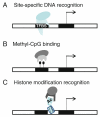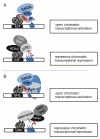Transcription factor effector domains
- PMID: 21557087
- PMCID: PMC4151296
- DOI: 10.1007/978-90-481-9069-0_12
Transcription factor effector domains
Abstract
The last decade has seen an incredible breakthrough in technologies that allow histones, transcription factors (TFs), and RNA polymerases to be precisely mapped throughout the genome. From this research, it is clear that there is a complex interaction between the chromatin landscape and the general transcriptional machinery and that the dynamic control of this interface is central to gene regulation. However, the chromatin remodeling enzymes and general TFs cannot, on their own, recognize and stably bind to promoter or enhancer regions. Rather, they are recruited to cis regulatory regions through interaction with site-specific DNA binding TFs and/or proteins that recognize epigenetic marks such as methylated cytosines or specifically modified amino acids in histones. These "recruitment" factors are modular in structure, reflecting their ability to interact with the genome via one region of the protein and to simultaneously bind to other regulatory proteins via "effector" domains. In this chapter, we provide examples of common effector domains that can function in transcriptional regulation via their ability to (a) interact with the basal transcriptional machinery and general co-activators, (b) interact with other TFs to allow cooperative binding, and (c) directly or indirectly recruit histone and chromatin modifying enzymes.
Figures



Similar articles
-
Enhancer function regulated by combinations of transcription factors and cofactors.Genes Cells. 2018 Oct;23(10):808-821. doi: 10.1111/gtc.12634. Epub 2018 Aug 31. Genes Cells. 2018. PMID: 30092612 Review.
-
Transcriptional activation by thyroid hormone receptor-beta involves chromatin remodeling, histone acetylation, and synergistic stimulation by p300 and steroid receptor coactivators.Mol Endocrinol. 2003 May;17(5):908-22. doi: 10.1210/me.2002-0308. Epub 2003 Feb 13. Mol Endocrinol. 2003. PMID: 12586842
-
Step out of the groove: epigenetic gene control systems and engineered transcription factors.Adv Genet. 2006;56:163-204. doi: 10.1016/S0065-2660(06)56005-5. Adv Genet. 2006. PMID: 16735158 Review.
-
Chromatin remodeling effects on enhancer activity.Cell Mol Life Sci. 2016 Aug;73(15):2897-910. doi: 10.1007/s00018-016-2184-3. Epub 2016 Mar 30. Cell Mol Life Sci. 2016. PMID: 27026300 Free PMC article. Review.
-
Genome-wide nucleosome mapping of Plasmodium falciparum reveals histone-rich coding and histone-poor intergenic regions and chromatin remodeling of core and subtelomeric genes.BMC Genomics. 2009 Dec 16;10:610. doi: 10.1186/1471-2164-10-610. BMC Genomics. 2009. PMID: 20015349 Free PMC article.
Cited by
-
Molecular Evolution and Inheritance Pattern of Sox Gene Family among Bovidae.Genes (Basel). 2022 Oct 2;13(10):1783. doi: 10.3390/genes13101783. Genes (Basel). 2022. PMID: 36292668 Free PMC article.
-
Heterogeneity of transcription factor binding specificity models within and across cell lines.Genome Res. 2016 Aug;26(8):1110-23. doi: 10.1101/gr.199166.115. Epub 2016 Jun 16. Genome Res. 2016. PMID: 27311443 Free PMC article.
-
Transcription factors ERα and Sox2 have differing multiphasic DNA and RNA binding mechanisms.bioRxiv [Preprint]. 2024 Mar 19:2024.03.18.585577. doi: 10.1101/2024.03.18.585577. bioRxiv. 2024. Update in: RNA. 2024 Jul 16;30(8):1089-1105. doi: 10.1261/rna.080027.124. PMID: 38562825 Free PMC article. Updated. Preprint.
-
Using High-Throughput Measurements to Identify Principles of Transcriptional and Epigenetic Regulators.Methods Mol Biol. 2024;2842:79-101. doi: 10.1007/978-1-0716-4051-7_4. Methods Mol Biol. 2024. PMID: 39012591
-
Corynebacterium tuberculostearicum, a human skin colonizer, induces the canonical nuclear factor-κB inflammatory signaling pathway in human skin cells.Immun Inflamm Dis. 2020 Mar;8(1):62-79. doi: 10.1002/iid3.284. Epub 2020 Jan 7. Immun Inflamm Dis. 2020. PMID: 31912662 Free PMC article.
References
MeSH terms
Substances
Grants and funding
LinkOut - more resources
Full Text Sources
Other Literature Sources

